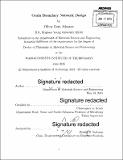Grain boundary network design
Author(s)
Johnson, Oliver Kent
DownloadFull printable version (15.23Mb)
Other Contributors
Massachusetts Institute of Technology. Department of Materials Science and Engineering.
Advisor
Christopher A. Schuh.
Terms of use
Metadata
Show full item recordAbstract
Grain boundaries in polycrystals form a complex interconnected network of intercrystalline interfaces. The crystallographic character of individual grain boundaries and the network structure of the grain boundary ensemble have been experimentally observed to have a strong influence on many materials properties. This observation suggests that if we could control the types of grain boundaries present in a polycrystal and their spatial arrangement then it would be possible to dramatically improve the properties of polycrystalline materials and tailor them to specific engineering applications. However, there are a number of major obstacles that have, until now, precluded the realization of this opportunity: (1) methods capable of simultaneously quantifying the crystallographic and topological structure of grain boundary networks do not exist; (2) theoretical models relating grain boundary network structure to physical properties have not yet been developed; and, consequently, (3) there are no techniques to quantitatively identify grain boundary network structures that would be beneficial for a given property. In this thesis I address these obstacles by first developing a new statistical description of grain boundary network structure called the triple junction distribution function (TJDF), which encodes both crystallographic and topological information. I establish new results regarding the physical symmetries of triple junctions and find a relationship between crystallographic texture and grain boundary network structure. I then use the TJDF to develop a model for the effective diffusivity of a grain boundary network. Finally, using the relationship between texture and grain boundary network structure that I develop, I describe a method for texture-mediated grain boundary network design. This process permits the theoretical design of grain boundary networks with properties tailored to a given engineering application and is applicable to any polycrystalline material. I demonstrate the potential of this technique by application to a specific design problem involving competing design objectives for mechanical and kinetic materials properties. The result is a designed microstructure that is predicted to outperform an isotropic polycrystal by seven orders of magnitude.
Description
Thesis: Ph. D., Massachusetts Institute of Technology, Department of Materials Science and Engineering, 2015. Cataloged from PDF version of thesis. Includes bibliographical references (pages 117-133).
Date issued
2015Department
Massachusetts Institute of Technology. Department of Materials Science and EngineeringPublisher
Massachusetts Institute of Technology
Keywords
Materials Science and Engineering.